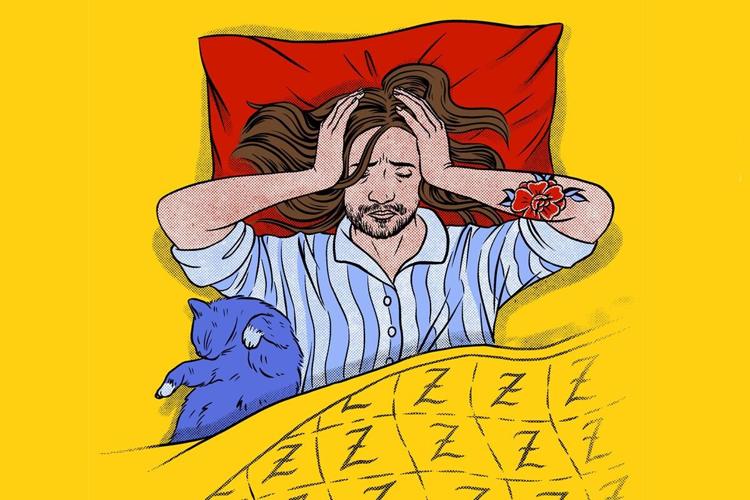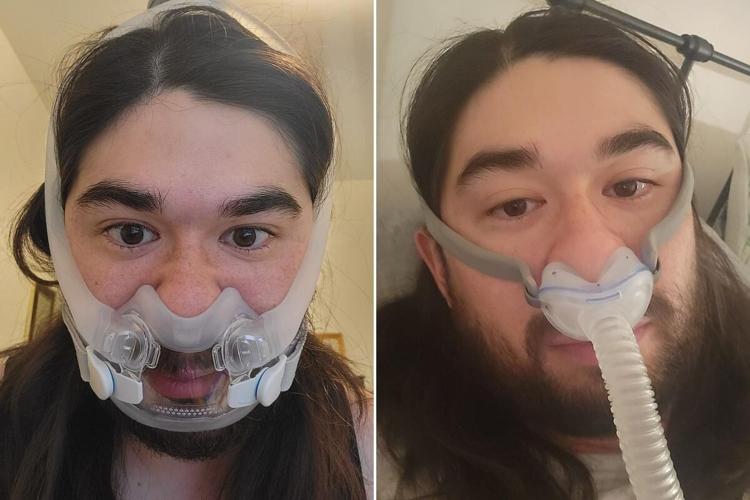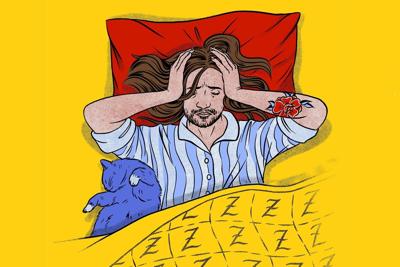The signs were there that I was slowly suffocating in my sleep.
After years of being elbowed to move over to the other side of the bed or having to do the occasional midnight migration to the couch, my partner had finally reached her limit. Then she started noticing the gasps.
Gillian, itãs just snoring, I would say.
Except it wasnãt ã and it wasnãt only drowning me, but also my better half. After many futile attempts at over-the-counter and behavioural remedies ã nasal strips, a giant wedge pillow to keep my head elevated, forcing myself to sleep on my side ã I had to concede that my snoring wasnãt a harmless nighttime nuisance, but potentially part of a dangerous disorder.
It wasnãt the only symptom: I was often tired during the day and took daily naps. Iãd frequent the bathroom at least twice a night. Iãd jolt awake ã usually from the sound of my own snoring ã with a racing heartbeat. Iãd sometimes go to bed early and wake up late feeling like I hadnãt slept at all.
Finally, after an overnight sleep study at a hospital, a doctor diagnosed me with what my partner and I had already begun to suspect. I have moderate obstructive sleep apnea or OSA ã I had an average of 26 events an hour where Iãd stop breathing for 10 seconds or more, just four events away from being labelled ãsevereã ã and was prescribed a CPAP (continuous positive air pressure) machine, which forces air through your airways so you can breathe at night.
ãItãs funny, I always joke to my patients that I probably get more referrals from wives than from any other doctor,ã says Dr. Mark Boulos, the medical lead at Sunnybrook hospitalãs sleep laboratory and a researcher at the University of Toronto. ãBut generally speaking, the scientific literature shows that the presence of sleep apnea, especially more severe forms, is associated with a lot of nasty consequences.ã
And those are? In the short term, thereãs evidence it has links to fatigue, depression, anxiety, difficulty concentrating and chronic headaches but, in the long term, untreated sleep apnea can also lead to cognitive decline, neurological diseases like dementia, and cardiovascular issues such as heart attacks and strokes.
It makes sense after all. Youãre not getting enough oxygen and rest while you sleep.
While I wasnãt surprised by the diagnosis, admittedly I was confused. Doesnãt sleep apnea only appear later in life in primarily older and overweight men, like your grandfathers and your great uncles? Iãm only 32, not overweight (yet) and an avid runner, so how can this be? And now youãre telling me I have to sleep with a tube attached to my face every single night for the rest of my life?
It turns out Iãm far from alone.

¤È§úèÓú½¿ìë½Star digital producer Justin Smirlies tries two different types of a CPAP masks, left being a version of the full face mask and the right being the nose “pillows” type that leaves the mouth uncovered.
Justin Smirlies/¤È§úèÓú½¿ìë½StarãI didnãt know anybody who had sleep apnea and was a young woman in their early 20s,ã Kajsa Bradley, a mental health blogger, told me over Zoom from her home in Portland, Ore. ãI was really intimidated (by the diagnosis). I felt a lot of guilt, a lot of shame, a lot of embarrassment.ã
If you do a quick search for #SleepApnea or #CPAP on Instagram and TikTok, youãll be greeted by tons of selfies and videos of people wearing their masks and demonstrating their devices, and interestingly youãll notice that many of these people are in their 20s, 30s and 40s ã a far cry from the stereotypical image of the old man strapped to a mask.
One of those faces is Bradley, now 29, who shares her experiences in blog posts and fun videos under the name of , which has more than 36,000 followers on TikTok. It was my sister, whoãs in her 30s and was diagnosed with sleep apnea around the same time as me, who pointed me to some of Bradleyãs videos.
Itãs these little snippets of content that make the CPAP treatment appear more accessible and less intrusive, and Bradleyãs goal is to provide the kind of guidance she was looking for when she was diagnosed in 2017. And it brings further awareness to the mental health aspect of sleep deprivation and more unique cases like hers; Bradley doesnãt suffer from snoring, the No.1 reported symptom related to sleep apnea.
ãItãs my testimonial of how much a CPAP has saved and changed my life,ã Bradley said.
OSA, the most common form of the disorder, typically occurs when the muscles at the back of the throat relax too much and block oneãs airways, and can be influenced and affected by a number of things such as weight, sleep position, tongue and throat size, face and neck shape, as well as alcohol use and smoking (and yes, this includes cannabis). But sometimes race and bone structure ã in my case, Iãm a mix of Filipino and Caucasian ã can be a factor.
ãSometimes itãs not actually easy to predict who may have sleep apnea or not,ã Boulos said, noting he sometimes sees young, slim Asian patients with some of the worst cases of sleep apnea. ãAnd it can really occur at any age.ã
In a , Statistics Canada reported that 6.4 per cent of Canadians over the age of 18 reported being diagnosed with sleep apnea, up from three per cent in a similar survey done in 2009. Although it can affect both men and women, the study noted that one in four men in Canada have a high risk of developing sleep apnea, especially later on in life.
ResMed, one of the companies that develops CPAP devices, released a study in 2019 that estimated roughly 170 million people across North and South America have sleep apnea. There have also been studies suggesting the disorder is more prevalent in Asian, Black, Hispanic and Indigenous populations.
Perhaps the public consciousness around the sleep disorder is changing and, in turn, the treatment is better, quieter and more widely available. Comedians such as Amy Poehler and Jo Koy (another half Filipino man like myself) have shared their experiences with sleep apnea and CPAP therapy, with the latter making it a . And in June it was revealed that U.S. President Joe Biden uses a CPAP device at night, too.
As for me, Iãve yet to experience the life-altering effects of my CPAP therapy, as Iãve read about online, despite being consistent with wearing the mask every night. Compliance is a huge issue with many who start off using a machine, but Iãm hopeful that even the small changes to my sleep habits can soon pay off. And more importantly, my snoring is gone and my wife no longer needs to leave our bedroom to get a good nightãs rest.
Boulos, however, is seeing something larger happening on a societal level in regards to sleep hygiene. People in general, especially younger adults, are really starting to take it seriously, as they should.
ãI think thereãs actually a good paradigm shift happening that kind of favours sleep and health,ã Boulos said, adding that heãs especially noticed an emphasis on better work-life balances with the graduate students he works with.
ãAnd I think we have something to learn from our younger generations.ã

Sleep apnea FAQ
I suspect I have sleep apnea, what now?
Go to your family physician, who will likely ask a number of questions about how youãre feeling and get a referral for an overnight study at a sleep disorder clinic. Itãs the only guaranteed way to get a diagnosis if you suspect sleep apnea. At-home sleep studies exist ã and are a bit more common in the U.S. ã but in-person studies are more accurate under the supervision of trained professionals. Yeah, youãre hooked up to a billion cables and itãs uncomfortable, but itãs still the ãgold standard,ã Boulos said.
I donãt share a bed or room with someone so I donãt know if I have moments where I stop breathing, and my doctor is not convinced. What can I do?
There might be some privacy concerns, but Boulos says a lot of sleep apps record and provide audio clips of snoring and sleep apnea episodes (I used an app called SnoreLab) that you can play back to your family physician. Smartwatch trackers, such as the Apple Watch and Fitbit, can also provide information on how well youãre sleeping, plus data on how much REM and deep sleep youãre getting and how many times you wake overnight. These shouldnãt be used as an alternative to a formal diagnosis, but rather give you a general idea of how well youãre sleeping.
I was diagnosed with sleep apnea but have to wait before getting a CPAP machine. What can I do in the meantime?
Sleeping on your side ã definitely not your back, where sleep apnea episodes are more likely to happen ã is the first step. Cutting down on alcohol and smoking would be another, as well as exercising and losing weight. Generally practising good sleep hygiene is a must. Also read and research about the machines and masks ahead of time. I found the r/sleepapnea and r/CPAP communities on Reddit helpful.
Arenãt these CPAP machines expensive?
Yes, but if you qualify under ã a consultant at a CPAP retailer can walk you through this process ã the provincial government covers 75 per cent of the machineãs cost. Leftover costs for the machine, as well as masks and other equipment can also be covered under private insurance plans provided by your employer. Keep in mind some insurance companies only provide coverage if youãre diagnosed with moderate to severe OSA (15-plus apnea events an hour), not mild.
Arenãt the masks huge and heavy and annoying?
Some are, but there are a lot of options that I wasnãt even aware of before I was diagnosed. Nasal masks and nasal ãpillowsã that only cover the nostril area are a lot more popular these days. But thereãs no single mask that works for everyone, so do your research on which might fit best for you.
I donãt want to wear the CPAP mask. Are there alternative treatments?
You might qualify for surgical intervention or another medical device (like a mouthpiece), but thatãs a conversation you should have with your doctor. But honestly, suck it up and wear the damn mask. Your body will thank you for it.































To join the conversation set a first and last name in your user profile.
Sign in or register for free to join the Conversation